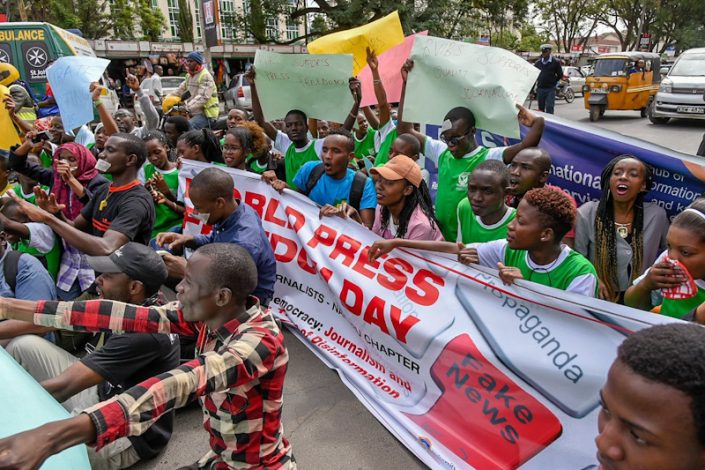The Media Council of Kenya (MCK) is urging dialogue with the government to mend a fractured relationship impacting critical reporting on national issues. This follows accusations of media bias, particularly in coverage of ongoing demonstrations.
Erosion of Trust: From Perception to Conflict
MCK CEO David Omwoyo identifies a critical issue: a lack of trust between media and government. He highlights a troubling shift: while politicians have found common ground since the 2022 election, the media is increasingly viewed with suspicion and hostility.
A statement issued by MCK paints a stark picture: “What began as a perception of bias has escalated into a full-blown conflict.”
This conflict manifests in “unwarranted threats, blame games, coercion, intimidation, and bad blood.”
Strained Relations and Conflicting Messages
According to the regulator, strained relations are further fueled by the government’s conflicting messaging and use of numerous spokespersons. This makes it difficult for journalists to obtain clear and consistent information.
Both sides trade accusations: media outlets are criticized for guest selection and framing of national conversations, while they counter with a lack of credible government voices.
“Media has been accused of bias in the guests invited to broadcast programmes and framing of national conversations, while on the other hand, the media claim lack of credible government voices and consistent messaging by officials when given a chance,” he said.
“Both the Government and the media have a common public interest, including a commercial and editorial relationship. Using commercial interests to get back at editorial misgivings is no better than utilising editorial position to revenge for unmet commercial expectations,” said MCK.

Balancing Reporting with Ethics
Despite the tense climate, MCK emphasizes the importance of ethical journalism. Omwoyo highlights The Code of Conduct for the Practice of Journalism in Kenya, which guides responsible reporting. This includes delaying broadcasts of violent scenes to avoid inciting violence.
Additionally, media houses have internal policies against live-streaming active violence.
“Whatever happens, do not switch off the cameras; Kenyans in the world rely on the media, to tell them what happened to people on the streets. …whatever happens, the media cannot leave the streets. The moment you switch up the camera from the streets, nobody will know what happened. And most of the noise we have now is about we want some cameras to be shut off and now we can have discussions about what can go live at what time and all that. But you can’t ask the media to leave a scene where something is happening,” said Omwoyo during a media dialogue with stakeholders.
“The Code of Ethics tells us that whenever the public interest outweighs privacy and bloody images, the public interest of our rights. And it’s my position without a doubt that the public interest overrides whatever issues we have.
The public interest in showing the bloody images and what is happening overrides any other cause for privacy, and it is an open discussion we can have about what to show live at what time, but we must not let that happen.”
Planned Protests and Media Responsibility
#WeAreNotCriminals pic.twitter.com/uMlbo8Vsrv
— KUJ Kenya (@KUJ_Kenya) July 22, 2024
Upcoming nationwide journalist protests on July 24th target police harassment and brutality. However, MCK urges media outlets to critically evaluate protesters’ demands, considering practicality and potential consequences.
MCK emphasizes the media’s responsibility to navigate the situation ethically and underscores the inherent tension between “commercial and editorial relationships” with the government. They argue that neither side should use its position for retaliation.
It calls on the government to prevent police harassment of journalists covering protests. Additionally, a unified government communication strategy is seen as crucial to avoid confusing and contradictory messaging.
Kenya’s Media Under Fire
The MCK’s push for dialogue comes amidst a broader context of declining press freedom in Kenya.
Journalists face threats, intimidation, and even physical attacks, creating a chilling effect on independent reporting, a recent media dialogue on Press Freedom and Access to Information in Kenya: Emerging Issues in 2024 organised by the Friedrich Naumann Foundation in Nairobi (FNF) and the Kenya Union of Journalists (KUJ) emphasised.
Recent incidents, like the shooting of Catherine Wanjeri wa Kariuki in Nakuru and the abduction of a Nation Media journalist, Macharia Gaitho, highlight the dangers faced by journalists.
“Historically, Kenya has persistently failed to take action against those responsible for attacks on journalists, human rights defenders, whistleblowers, and protesters. The government has been largely ineffective in investigating these crimes and prosecuting the perpetrators and instigators,” says Article 19.
On the other hand, the Kenyan media sector is crippled by debt, with the government owing media houses over 1 billion shillings. This financial dependence weakens the media’s ability to hold the government accountable.
Finally, existing laws like the Kenya Information and Communication Act and the Computer Misuse and Cyber Crimes Act contain ambiguities often exploited to silence journalists.
The lack of legal protections for journalists’ sources creates an additional hurdle for investigative reporting.
The Fight for Media Independence
The Kenya Media Sector Working Group (KMSWG), a coalition of media stakeholders and associations committed to freedom of the media and expression, is seeking solutions. Proposals like a Media Development Fund aim to improve financial sustainability and reduce dependence on the government.
The future of press freedom in Kenya remains uncertain. While the media actively fights for its independence, a concerted effort from journalists, civil society, and the government is needed to address financial pressures, legal ambiguities, and violence targeting the media.




